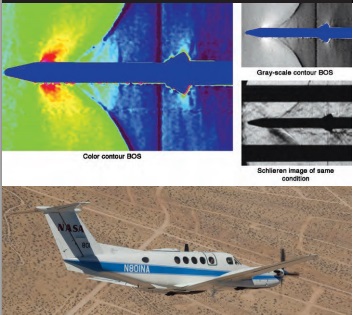Chapter: Supersonic Flight Research, new invention technology, Research project papers,
Air-to-Air Background-Oriented Schlieren

Air-to-Air Background-Oriented Schlieren
This research project
is using a synthetic schlieren technique to study the effects of shock waves on
high-speed air travel as part of a larger NASA effort to develop a quieter
supersonic vehicle. Conventional schlieren techniques typically require expensive
lighting, mirrors, and precise alignment to visualize density gradients and
enable shock wave visualization. This technology instead uses computer image
processing technology and a less expensive background-oriented schlieren (BOS)
technique to visualize shock waves in a wind tunnel. (BOS requires only a
charge-coupled device [CCD] camera, a light source, and a speckle-type
background, making it a much simpler and less costly option for flow
visualization.) This research effort is the first to use a BOS technique to
visualize supersonic aircraft shock waves in flight.
Work to date: The team conducted a
flight test over the desert using a King Air aircraft equipped with
a camera and recording an F/A-18 flying under it at supersonic speed.
Researchers used the results to validate the BOS technique.
Looking ahead: The team plans to
conduct additional tests with more advanced cameras to obtain
higher resolution images. The ultimate goal of NASA's shock wave research is to
find ways to control shock waves and lessen their noise so that it may be
possible for supersonic flight to become more routine.
NASA Partner: Ames Research Center
Benefits
Novel: Employs a unique application of a technique
to understand how shock waves affect supersonic vehicles
Advanced: Furthers knowledge and tools in
NASA's quest to design quieter supersonic planes
Supersonic Flight Research
Supersonic flight over land is currently severely restricted
because sonic booms created by shock waves disturb people on the ground and can
damage private property. Since the maximum loudness of a sonic boom is not
specifically defined by the current Federal Aviation Administration (FAA)
regulation, innovators at NASA have been researching ways to identify a
loudness level that is acceptable to both the FAA and the public and to reduce
the noise created by supersonic aircraft. Using cutting-edge testing that
builds on previous supersonic research, NASA is exploring low-boom aircraft
designs and other strategies that show promise for reducing sonic boom levels.
A variety of factors, from the shape and position of aircraft
components to the propulsion system's characteristics, determine the make-up of
a supersonic aircraft's sonic boom.
Related Topics